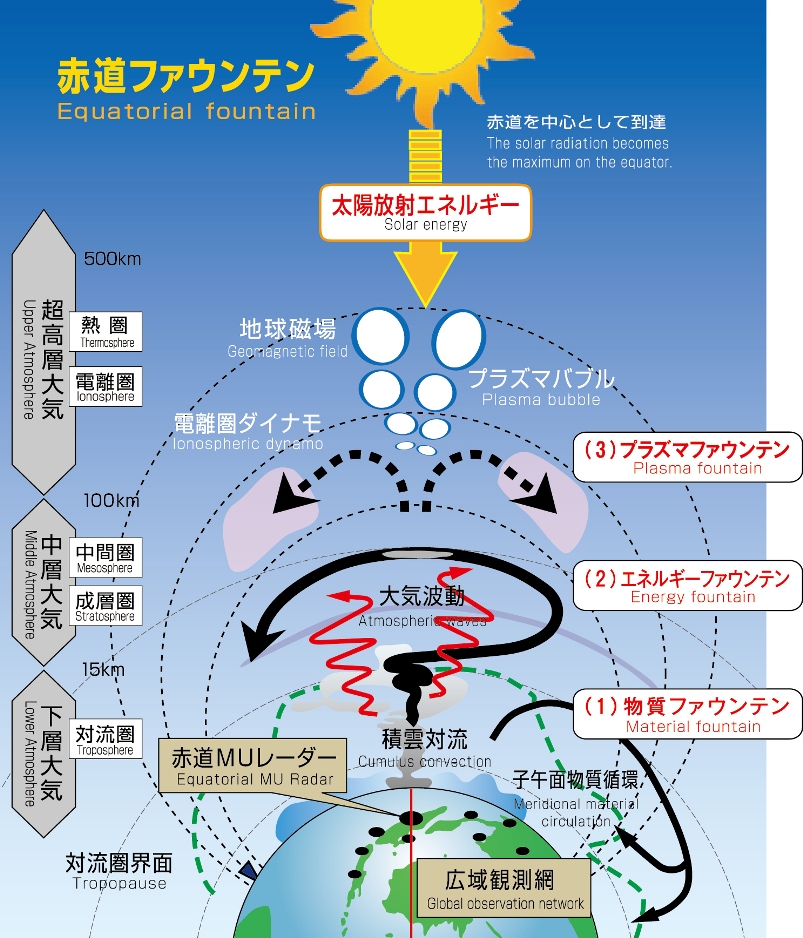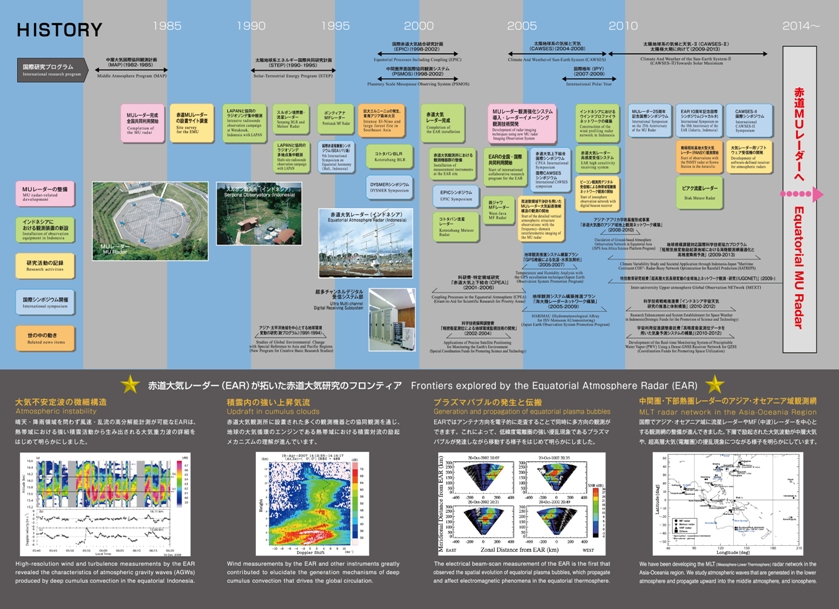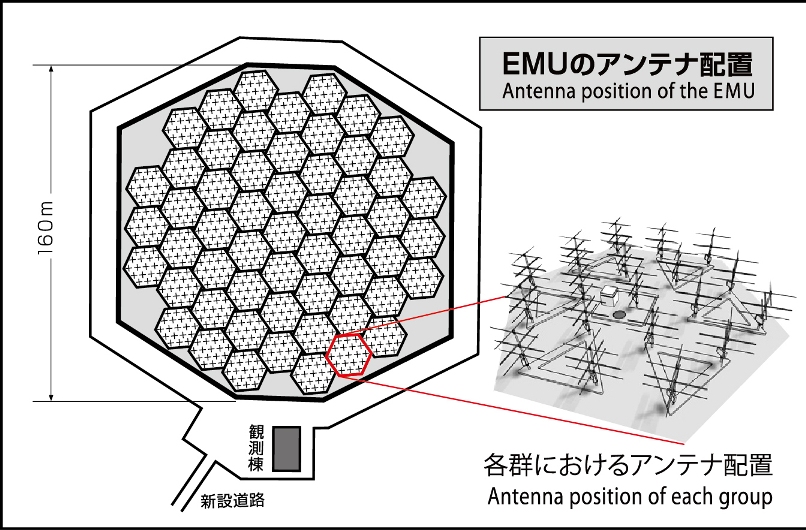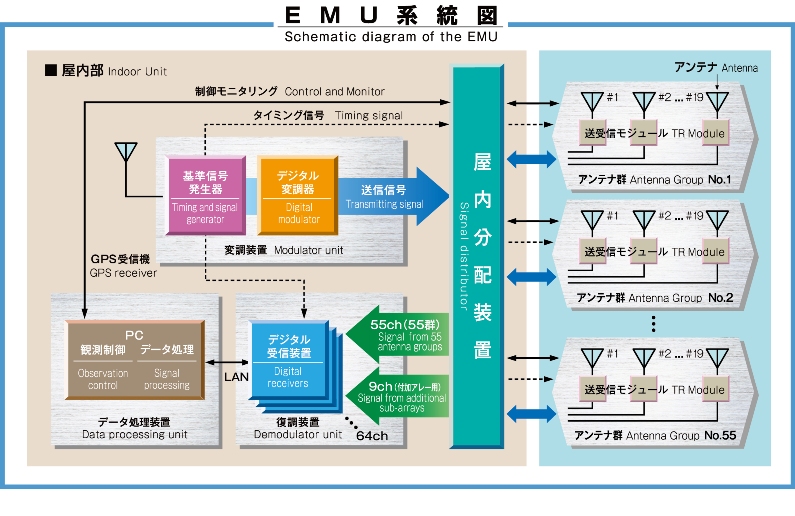
Japanese
Download of Equatorial MU Radar Pamphlet (3MB)
(2014 version (9MB), 2017 version (3MB))
New scientific challenges of the Equatorial Middle and Upper Atmosphere Radar (EMU)
- The state-of-the-art techniques established by the MU radar are used in the EMU radar to discover and clarify unknown phenomena in the equatorial atmosphere.
Radar imaging techniques are used to resolve multi-scale fundamentals of the dynamical processes.
- The high sensitivity of the EMU radar enables measurements of the winds in the mesosphere/thermosphere and ionospheric parameters.
Studies on energy and material flow in the equatorial atmosphere (Equatorial Fountain) will be conducted at a wide range of altitudes.
- The EMU radar along with other giant atmospheric radars such as
the MU radar,
PANSY, and
EISCAT_3D radar
will constitute a global observation network.
This network will enhance studies on coupling processes in the solar-terrestrial system.
- The EMU radar will be operated under close long-term collaboration between Japan and Indonesia.
It will be open to the international community and utilized in the education of young scientists from around the world.
Equatorial Fountain
The energy and material flows that occur in all height regions of the equatorial atmosphere are referred to as the ''Equatorial Fountain'', which will be studied with the EMU radar.
- Material fountain
Different kinds of materials in the atmosphere are emitted from land- and sea-surfaces in the equatorial region.
As they circulate in the troposphere, they help generate cumulus and/or cirrus clouds.
These materials flow into the stratosphere through the tropopause like a fountain and widely reach the middle and high latitude regions.
- Energy fountain
Atmospheric waves originating in the troposphere transfer their energy and momentum like a fountain up to the middle atmosphere, where peculiar long-term waves and irregularities are induced.
- Plasma fountain
The ionospheric plasma around the geomagnetic equator is blown upward by the dynamo electric field induced by the background neutral winds, and is known as the plasma fountain.
Various energy exchanges and plasma-density fluctuations are induced through the coupling between the dynamics and electromagnetics.

Research Trends
1984- MU Radar
The MU (Middle and Upper atmosphere) radar,
located at the Shigaraki MU Observatory, Shigaraki, Koka, Japan, is known as the most capable atmospheric radar in the world and is one of the largest radars in Asia.
Since its installation in 1984, it has been used to study the variability of the atmosphere from meteorology to upper atmosphere dynamics.
The MU radar uses VHF radio waves at 46.5 MHz with a peak output power of 1 MW.
The antenna area consists of 475 Yagis arranged in a circular array of 103-m diameter, which enables fast beam steerability and flexibility for diverse observations.
IEEE Milestone was dedicated to the MU radar as the world first large-scale MST radar with a two-dimensional active phased array antenna system.
This is an honor bestowed to significant historical technical achievements in study areas of electric, electronics, information, and communications.
Following the MU radar, recent atmospheric radars employ a similar system design.
2001- Equatorial Atmosphere Radar
The Equatorial Atmosphere Radar (EAR)
is a large atmospheric radar located at the Kototabang Atmosphere Observatory right over the equator in West Sumatra, Indonesia.
It operates at 47 MHz and consists of 560 Yagi antennas in a near-circular field with a 110-m diameter.
The bottom of each Yagi antenna is equipped with a compact transmit-receive module.
EAR has almost the same functionality as the MU radar, except that its output power is 100 kW.
It can observe winds and turbulence in the height range of 1.5 km to 20 km (troposphere and lower-stratosphere) as well as ionospheric irregularities over 90 km.
2020- Equatorial MU Radar
The EMU radar plan is based upon achievements and knowledge to date, and as well advances in the research project ''Study of coupling processes in the solar-terrestrial system''.
We conducted a topographic survey of the location, which completed the detailed system design, including the installation method.
Additionally, the environmental assessment necessary for construction is completed.
The EMU radar will be installed north of the EAR.

History and Frontiers explored by the Equatorial Atmosphere
- Atmospheric instability
High-resolution wind and turbulence measurements by the EAR revealed the characteristics of atmospheric gravity waves (AGWs) produced by deep cumulus convection in the equatorial Indonesia.
- Updraft in cumulus clouds
Wind measurements by the EAR and other instruments greatly contributed to elucidate the generation mechanisms of deep cumulus convection that drives the global circulation.
- Generation and propagation of equatorial plasma bubbles
The electrical beam-scan measurement of the EAR is the first that observed the spatial evolution of equatorial plasma bubbles, which propagate and affect electromagnetic phenomena in the equatorial thermosphere.
- MLT radar network in the Asia-Oceania Region
We have been developing the MLT (Mesosphere-Lower Thermosphere) radar network in the Asia-Oceania region. We study atmospheric waves that are generated in the lower atmosphere and propagate upward into the middle atmosphere, and ionosphere.

Hardware system of the EMU
A large-sized antenna array with a 160-m diameter and 500-kW peak output power enable the EMU radar to be ten times more sensitive than the EAR.
For radar imaging measurements, the 1045 Yagi elements can be divided into 55 sub-arrays. Each sub-array is composed of 19 Yagi elements.

The EMU radar is comprised of antennas, TR Modules, a data processing unit, a modulator unit, and a demodulator unit.
Multi-channel digital signal processing realizes the full measurement capability of the EMU radar.

Specifications of the EMU
- Configuration: Monostatic pulse Doppler radar
- Center frequency: 47.0 MHz
- Antenna configuration: A quasi-circular array consisting of 1045 crossed Yagi antenna with 3 elements
- Antenna Apeature: About 16,000m2
- Beam directions: Arbitrary direction within a zenith angle of 30 degrees
- Tramsmitter configuration: 1045 solid-state TR modules
- Peak power: 500 kW (minimum)
- Polarization: Circular polarization
- Receiver configuration: 55+9 channels of synchronous quadratic datection
Associated instruments at the EMU site
At the EMU site, various instruments are installed through collaborations with other research institutes.
Operation of the instruments including the EMU and studies using them are carried out in close collaboration with National Institute of Aeronautics and Space (LAPAN) and other Indonesian research institutes.
The coordinated observations using the EMU and collocated instruments are expected to discover and clarify various phenomena occurring in the equatorial atmosphere.





